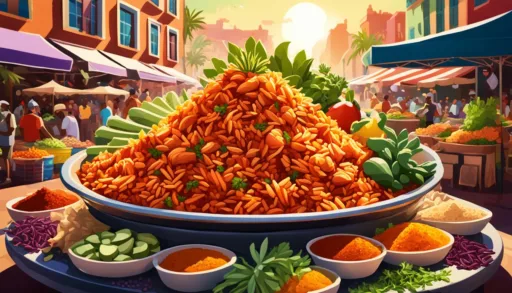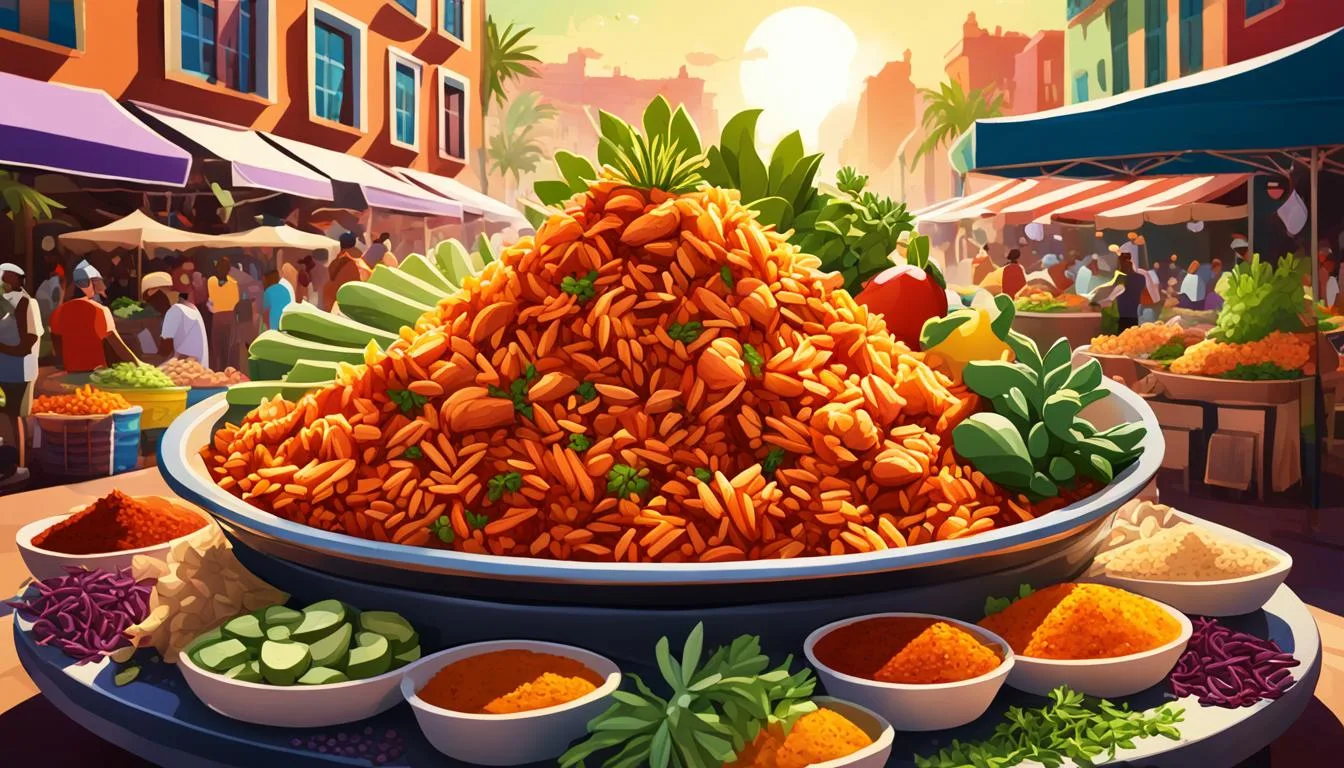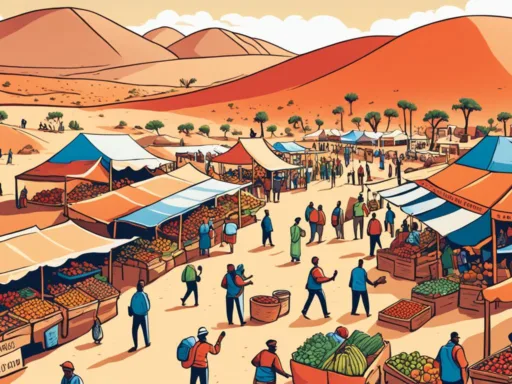Welcome to a culinary journey that ventures into the heart of West Africa. Imagine a place where the food is an untold story of flavors waiting to be discovered, where each dish resonates with cultural history and tells a tale of diversity and richness. That place is Sierra Leone. This small, yet gastronomically mighty country offers a treasure trove of Sierra Leonean Cuisine Discoveries that are stirring up the global food scene.
As we explore Sierra Leonean gastronomy, we journey through bustling markets, savor street-side delicacies, and indulge in dishes that echo the country’s vibrant heritage. From the iconic cassava leaves to the fusion of Lebanese flavors that reveal its complex history, Sierra Leone food is as eclectic as the landscape from which it originates. Let’s unearth the culinary gems of Sierra Leone that have remained hidden — until now.
Key Takeaways
- Discover the diverse and unique flavors of traditional Sierra Leonean cuisine.
- Learn about the impact of history and culture on Sierra Leone food, revealing a love affair with robust tastes.
- Understand why Sierra Leonean gastronomy is gaining attention on the global culinary stage.
- Experience the vibrant fusion of local and international influences shaping Sierra Leone’s gastronomic identity.
- Explore the reasons behind the culinary world’s rising interest in the rich cuisine of Sierra Leone.
- Get a glimpse of the food scene transformation in Sierra Leone, poised for an exciting year ahead.
Introduction to the Flavors of Sierra Leone
With a cuisine as vibrant and diverse as its culture, Sierra Leone invites culinary explorers to taste its rich array of traditional dishes. Now on the cusp of global recognition, Sierra Leone’s gastronomy is a flavorful mosaic of ingredients and recipes, ready to be discovered by food aficionados the world over. Influential chefs and restaurants have begun showcasing the culinary delights of Sierra Leone, tantalizing the palates of diners with dishes steeped in tradition yet bursting with innovative twists.
The Rising Interest in Sierra Leone’s Food Scene
The culinary scene of Sierra Leone, affectionately known as “Sweet Salone,” is rapidly rising in prominence, with food lovers across the globe eager to explore the nation’s gastronomic treasures. Esteemed West African restaurants in London such as Chishuru, Ikoyi, and Akoko have played a pivotal role in putting Sierra Leonean cuisine in the spotlight, serving up traditional Sierra Leonean dishes with contemporary flair.
Unveiling the Essence of Sierra Leonean Cuisine
At the heart of Sierra Leonean cuisine lies a rich tapestry of flavors, intertwining local staples with a harmonious balance of sweet, savory, and spicy. Beneath the surface of popular Western African dishes lie Sierra Leonean cuisine explorations characterized by a distinctive use of ingredients like hibiscus, chili, smoked fish, tamarind, and okra. Maria Bradford’s celebrated cookbook offers a gateway to the traditional staples and street foods of Sierra Leone, effectively marking the country as an emerging culinary destination with its groundnut stew, cassava bread, and Benny cake.
As we delve deeper into the flavors that define Sierra Leonean gastronomy, we find an authentic reflection of the country’s rich heritage. Each traditional recipe tells a story—whether it’s the communal enjoyment of pepper soup or the treasured taste of krinkrin and fishballs—a narrative that Maria Bradford has lovingly curated in her collection of vibrant Sierra Leonean recipes. Bradford’s contribution to the culinary world goes beyond her cookbook; she provides a profound insight into the heart of Sierra Leone, setting the stage for a broader appreciation and understanding of its remarkable cuisine.
Sierra Leonean Cuisine Discoveries Through a Chef’s Lens
Within the pages of “Sweet Salone: Recipes from the Heart of Sierra Leone,” Maria Bradford masterfully brings to life an entire world of authentic Sierra Leone recipes. Her personal culinary narrative is infused with the cultural richness that defines Sierra Leonean Cuisine Discoveries, bridging the gap between a storied past and an innovative present. Bradford’s impact on the culinary scene extends beyond her popular UK-based food brand, Schwen Schwen, demonstrating the versatility and depth of Sierra Leone’s gastronomic traditions. Her cookbook is more than a mere collection of recipes; it is a testament to the resilience and creativity of Sierra Leonean cooks.
By connecting her culinary roots with avant-garde techniques, Bradford showcases how Sierra Leonean cuisine is both a historical recollection and a vibrant contemporary movement.
With Bradford’s guidance through her book and food initiatives, she advocates for the global recognition of West African flavors. She introduces her audience to a tantalizing array of dishes that exemplify the multifaceted aspects of traditional tastes and modern flares.
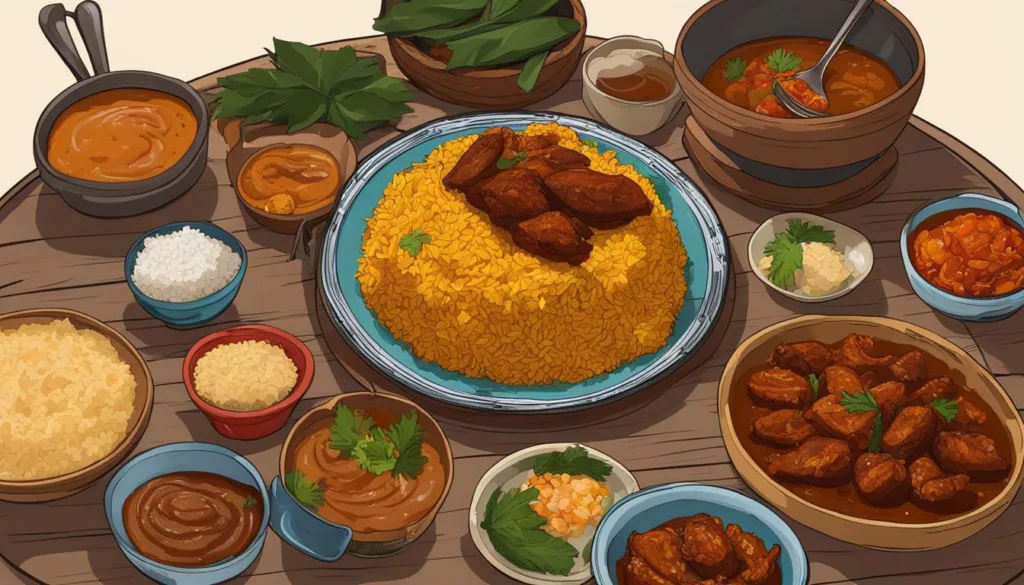
Here is a glimpse into the melting pot of ingredients and techniques that Maria Bradford cheerfully integrates into her creations:
- The nutty richness of groundnut stew transformed with a modern twist.
- Classic cassava leaves, given a new life with Afro-fusion elements.
- Innovative takes on the staple Jollof rice, delighting palates across borders.
Bradford’s work is not just an exploration of taste, but a cultural journey through Sierra Leonean cuisine that has long been overshadowed on the international stage. However, through her lens, every simmer, spice, and story becomes a stepping stone towards gastronomic recognition. It’s these heartfelt and vibrant Sierra Leonean Cuisine Discoveries that are now beckoning food lovers worldwide to delve deeper into the culinary soul of Sierra Leone.
Navigating the Culinary Landscape of Freetown
As you explore Sierra Leonean gastronomy, the vibrant capital of Freetown unfolds a rich tapestry of tastes and aromas. Through the bustling streets and marketplaces, one can truly taste the flavors of Sierra Leone, offering a unique experience that blends traditional cuisine with a touch of global essence.
A Melting Pot of Sierra Leonean and International Influences
Within the borders of Freetown, the harmony of local and international cuisines is evident. Here, a visitor can indulge in traditional stews, meticulously prepared with locally sourced ingredients, while also having the option to savor a range of Lebanese-inspired creations that showcase the city’s cultural diversity. This melting pot of gastronomy invites food lovers to sample renowned staples and exotic fusions alike.
Freetown’s Favorite Street Foods
The authentic popular Sierra Leonean foods can be found in the heart of the city’s streets. Amidst the chatter and vibrant energy, various vendors present a selection of enticing street foods that capture the essence of Sierra Leone’s culinary spirit.
| Street Food | Main Ingredients | Texture & Flavors |
|---|---|---|
| Puff-Puff | Flour, Sugar, Yeast | Soft & Sweet |
| Kukhri | Rice, Peanut Sauce | Crunchy & Nutty |
| Cassava Leaves Stew | Cassava Leaves, Palm Oil, Fish or Meat | Hearty & Earthy |
| Lebanese Shawarma | Meat, Vegetables, Garlic Paste, Flatbread | Savory & Spiced |
To explore Sierra Leonean gastronomy is to embark on a journey of flavor that goes beyond just eating; it is a cultural immersion that pleases the palate and enriches the soul. In Freetown, every taste is a morsel of history, each dish a tale of converging cultures and shared love for good food.
Signature Sierra Leonean Dishes Every Foodie Must Try
Sierra Leonean Cuisine Discoveries continue to intrigue and satisfy appetites around the world. The palette of traditional Sierra Leonean dishes is a testament to the nation’s love for intense flavors and wholesome ingredients. Here are a few quintessential dishes that promise to delight every food lover.
- Cassava Leaves Stew: A staple in Sierra Leonean households, this stew is hearty and filled with nutrient-rich cassava leaves, often accompanied by beef or fish.
- Jollof Rice: This vibrant dish, with its tomato base and spices, tells a story of trade routes and cultural exchanges across West Africa.
- Fried Plantains: A sweet, caramelized treat that complements the bold flavors found in main courses.
| Dish | Main Ingredients | Flavor Profile |
|---|---|---|
| Okra Soup | Okra, meat, palm oil | Rich, gumbo-like texture, earthy |
| Groundnut Soup | Groundnuts, chicken, spices | Savory, creamy, with a nutty undertone |
| Pepper Soup | Fish or meat, pepper, spices | Hearty, spicy kick, aromatic |
Discovering these Sierra Leonean Cuisine Discoveries places any food enthusiast at the heart of Sierra Leone’s rich culinary heritage. The simplicity of ingredients belies the complexity of flavors that are waiting to be experienced. Traditional recipes provide a comforting glimpse into the daily life and history of this vibrant culture.
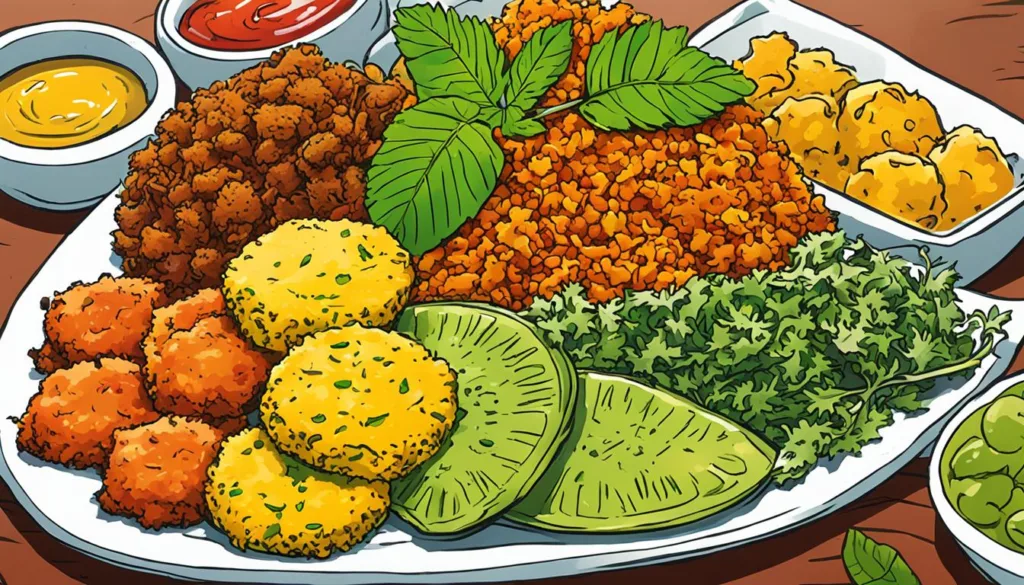
Whether it’s the comfort of a stew or the zest of a spicy soup, the traditional dishes await to tell their tales through every bite. – A Culinary Explorer
Indeed, to journey through Sierra Leonean cuisine is to engage in an edible dialogue with the past and present, a dialogue that’s both delicious and profoundly enlightening for any foodie’s soul.
The Role of Local Ingredients in Sierra Leonean Gastronomy
Sierra Leone food is the result of a bounty of local ingredients that form the core of its rich culinary identity. These ingredients are more than just basics; they’re the stars that make authentic Sierra Leone recipes come alive, with flavors that resonate with the soul of the country’s gastronomy. Delving into these local components allows us to explore Sierra Leonean gastronomy’s true essence, transforming a simple meal into a cultural experience.
Staples of Sierra Leonean Cooking
At the heart of many traditional dishes are staples like soft, fluffy rice, vibrant leafy greens—including cassava and sweet potato leaves—and rich, flavorsome palm oil. Integral to Sierra Leonean cooking, they enrich dishes with their essential nutritional value and are a testament to the sustainable practices of the nation’s agriculture.
- Rice – the ubiquitous base for many meals
- Leafy Greens – including cassava leaves, a favored component of the famous cassava leaves stew
- Palm Oil – lends a unique taste and reddish color to stews and soups
Exotic Flavors: From Okra to Tamarind
The palette of Sierra Leonean flavors is diversified with exotic tastes. The versatility of okra, the tanginess of tamarind, the rich aroma of smoked fish, and the fiery punch of chili are significant for their unique contributions to the country’s gastronomy. Together they encapsulate the vibrant exuberance of Sierra Leone’s food landscape.
| Ingredient | Role in Cuisine | Typical Dishes |
|---|---|---|
| Okra | Thickening soups and adding texture | Okra Soup |
| Tamarind | Providing a sweet and sour flavor | Tamarind Juice and Sauces |
| Smoked Fish | Lending depth to stews | Potato Leaf Stew |
| Chili | Spicing up dishes | Pepper Soup, Jollof Rice |
These indigenous ingredients not only serve as the backbone for authentic Sierra Leone recipes but also represent a rich agricultural tradition that supports the local economy and underpins the gastronomic culture of the nation. When we explore Sierra Leonean gastronomy, we’re not just indulging in mouthwatering flavors; we’re engaging with a heritage that has been meticulously cultivated from one generation to the next.
Tradition Meets Innovation in Sierra Leonean Cooking
The culinary landscape of Sierra Leone is a dynamic blend of time-honored practices and creative modernity, mirroring the country’s adaptability and rich cultural ethos. At the forefront of this gastronomic renaissance is the talented Maria Bradford, whose interpretations of traditional Sierra Leonean dishes have ushered in a wave of excitement surrounding Sierra Leonean Cuisine Discoveries.
Maria Bradford’s Cookbook: A Celebration of Heritage
Bradford’s work, particularly evident in her cookbook “Sweet Salone,” serves as a testament to the resilience and splendor of traditional Sierra Leonean dishes. Each recipe is Bradford’s heartfelt ode to her roots, carefully balancing authenticity with innovation, and as a result, her dishes resonate with both nostalgia and a fresh perspective.
Afro-Fusion Cuisine: Blending Old and New
Bradford’s unique culinary style exemplifies the enchanting dance of Afro-fusion dishes, where her profound respect for the past interacts seamlessly with contemporary tastes. Her culinary creations have not only captured the essence of Sierra Leonean flavors but have also sparked curiosity and enthusiasm worldwide for the country’s cuisine.
In recognizing the importance of heritage ingredients like palm oil, Bradford stresses the significance of sustainable practices. She advocates for farming methods that guard the ecosystem while ensuring the persistence of culinary traditions that have been shared over generations.
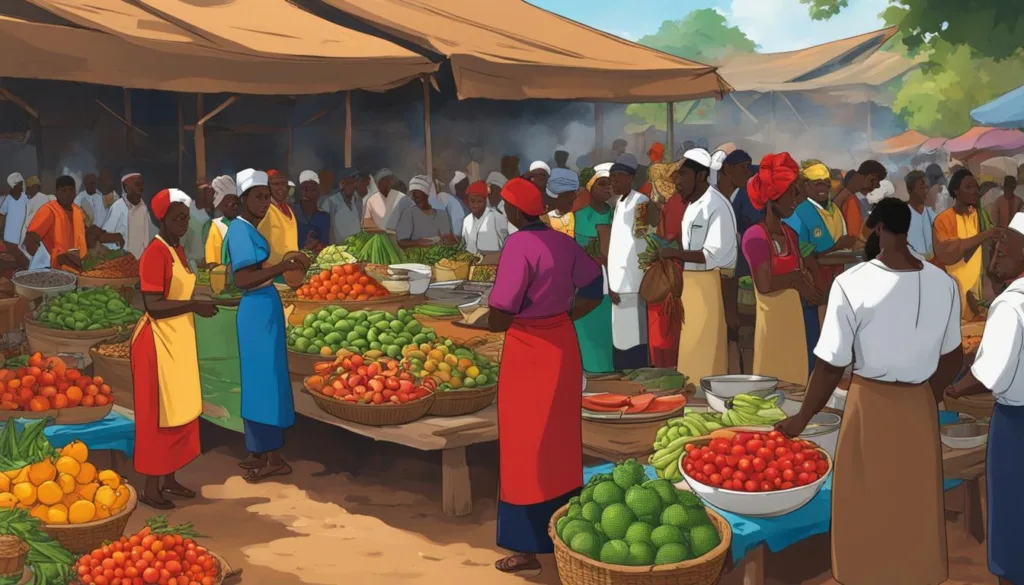
| Traditional Sierra Leonean Dish | Modern Afro-Fusion Interpretation |
|---|---|
| Plasas Sauce | Plasas with Infused Lemon Grass Oil |
| Palm Wine Chicken | Palm Wine Chicken with Spiced Couscous |
| Cassava Leaf Stew | Deconstructed Cassava Leaf Stew in Phyllo Pastry |
| Jollof Rice | Smoked Jollof Risotto with Seared Scallops |
| Groundnut Soup | Groundnut Bisque with a Suya Spice Drizzle |
As we explore the collaborations of tradition and innovation within Sierra Leonean cooking, Maria Bradford’s approach serves as an inspiring blueprint for culinary artists worldwide. The journey of Sierra Leonean Cuisine Discoveries continues to unfold, charting new territories while staying firmly rooted in its rich culinary heritage.
Sierra Leonean Cuisine on the World Stage
As Sierra Leonean cuisine exploration continues, the flavors that characterize this vibrant nation have begun stepping out into a broader arena, gracing tables and menus across the globe. Spearheaded by passionate culinarians and fueled by a loving diaspora, the culinary delights of Sierra Leone are enchanting foodies everywhere, making a mark in the international food scene.
From Sweet Salone to Global Gourmet Destinations
The savory and soulful dishes of Sierra Leone have traveled far from the bustling markets of Freetown, finding new homes in cosmopolitan cities worldwide. Major metropolises are now becoming bastions of Sierra Leonean gastronomy, turning eateries into windows to West Africa, and transforming the culinary landscape into a global tapestry of tastes.
The Spread of Sierra Leonean Dishes Abroad
The spread of Sierra Leonean dishes to distant shores is not only a testament to their rich and enticing flavors but also to the strength of cultural ties. As chefs and home cooks alike share the recipes of their homeland, the world is introduced to a cuisine that is both hearty and heartwarming, making Sierra Leonean food a strong contender on the global gourmet stage.
The Cultural Tapestry of Sierra Leonean Food
As we delve into the rich fabric of Sierra Leone’s society, it’s apparent that the culinary delights of Sierra Leone are much more than a palette of flavors—they represent a storyline of multicultural influence and community bonds. The foods of Sierra Leone are a canvas, painted with the diversity of its ethnic groups, each adding its unique hue to create a harmonious masterpiece.
Ethnic Diversity and Its Culinary Impact
The multitude of ethnicities in Sierra Leone, including the Mende, Temne, and Limba to name a few, have each contributed to the culinary heritage of this nation. The interplay between these cultures culminates in a gastronomic symphony, inviting you to taste the flavors of Sierra Leone and experience a piece of its history with every bite.
How Meals Weave Stories of Community and Heritage
In Sierra Leonean culture, meals are much more than the act of eating; they are a communal event, synonymous with unity and the sharing of heritage. These shared meals become not just food for the body, but nourishment for the soul, strengthening the familial ties and reinforcing social values.
| Cultural Group | Signature Dish | Key Ingredients | Historical Significance |
|---|---|---|---|
| Mende | Fufu and Soup | Cassava, plantains, meat or fish | A staple meal reflecting farming heritage |
| Temne | Krankenkro | Black-eyed beans, palm oil, sweet potato leaves | Symbolizing resourcefulness in local cuisine |
| Limba | Ogbono Soup | Ogbono seeds, vegetables, fish or meat | Derived from forest-foraged seeds, showing the link between environment and diet |
Culinary Exploration: Sierra Leone’s Influence Beyond Africa
As the tastes and traditions of Sierra Leone continue to traverse global boundaries, we see the Sierra Leonean Cuisine Discoveries fostering a newfound appreciation for this region’s gastronomic prowess. Rich in flavors and steeped in history, popular Sierra Leonean foods have carved a niche for themselves in the diverse culinary landscape far from their homeland. A testament to this far-reaching influence is the profound connection with the Gullah Geechee community in the American South who share rice-growing heritage and culinary practices with Sierra Leone.
Savory aromas and rich, piquant sauces from Sierra Leone’s kitchens echo within the Gullah Geechee corridor, ringing with similarities that hark back to centuries-old bonds. It is more than a mere exchange of recipes—it is a revival of historical ties that emphasize the power of cuisine as a medium for cultural preservation and dialogue.
The global storytelling of Sierra Leone’s food culture mirrors a narrative where every spice added and every rice grain cooked signifies a piece of a shared historical tapestry. Below, we explore how Sierra Leone’s culinary influence not only compliments but also enriches the global culinary scene:
- Jollof Rice: A beloved dish within Sierra Leone, it resonates profoundly with the soul-food classics in Southern American cooking, illustrating the cross-cultural culinary pollination.
- Cassava Leaves: As a versatile green, cassava leaves make a significant appearance in both Sierra Leonean and Gullah dishes, showcasing the adaptability and legacy of African edible greens.
- Palm Oil: The vibrant red palm oil, essential in Sierra Leonean cuisine, has left its mark in the Gullah heritage, underpinning the deep-rooted practice of using local ingredients to create bold flavors.
As Sierra Leonean flavors continue to captivate palates across the globe, they offer a gateway to exploring West Africa’s hidden gem, inviting everyone from casual diners to serious food enthusiasts to immerse themselves in a unique culinary exploration. The influence of Sierra Leonean Cuisine Discoveries on the world stage serves not just as a celebration of the nation’s fare but as a vibrant thread woven into the fabric of global gastronomy.
Sustainable Practices and Sierra Leonean Cuisine
The journey into the heart of Sierra Leonean cuisine exploration is one steeped in rich flavors and a commitment to sustainability. One of the cornerstones of this culinary heritage is the use of palm oil, a staple that is as much a part of the region’s identity as it is a subject for environmental discussions globally. The robust red oil is not just a kitchen favorite; it’s a symbol of sustainable Sierra Leone cuisine.
This essential ingredient, while commonly garnered from large-scale deforestation practices worldwide, takes a different and more eco-friendly path in Sierra Leone. The country’s focus on small-scale cultivation is a shining example of how tradition and environmental consciousness can align seamlessly.
Palm Oil – Balancing Tradition with Environmental Consciousness
Emphasizing the importance of environmentally friendly practices, here is an illustration of how Sierra Leone positions itself as an example of sustainability in the West African palm oil industry:
| Sustainable Practice | Description | Impact |
|---|---|---|
| Small-Scale Farming | Local communities engaging in traditional, low-impact farming methods. | Limited environmental footprint and support for local economies. |
| Agroforestry | Integrating crops within native forest areas to preserve biodiversity. | Fosters a healthier ecosystem while providing raw materials. |
| Natural Cultivation | Avoiding the use of harmful pesticides and fertilizers in farming practices. | Ensures the health of both the land and the consumer. |
| Community-Based Initiatives | Cooperatives that manage the production and distribution of palm oil. | Empowerment of local people and equitable distribution of resources. |
The dedication of Sierra Leone to a model of sustainable cultivation cannot only preserve its lush landscapes and diverse ecosystems but also set a precedent for responsible gastronomy. With each step towards responsible farming, Sierra Leone enhances the respect for its culinary gifts while nurturing the very earth that cradles it.
Conclusion
Our gastronomic voyage into the heart of West Africa culminates here, but the flavors and memories of Sierra Leonean Cuisine Discoveries linger, inviting savors of exploration. The journey through the traditional Sierra Leonean dishes, from the hearty stews to the invigorating soups, reveals a narrative of a nation rich in cultural heritage. Authentic Sierra Leone recipes hold the essence of the nation’s spirit, serving not only as nourishment but also as testament to its resilient and vibrant culture.
Embracing the Rich Tapestry of Sierra Leone’s Culinary Arts
The culinary arts of Sierra Leone are to be celebrated, a kaleidoscopic heritage of tastes that have simmered through time. Each spice and every technique harnessed in the making of these traditional Sierra Leonean dishes tells a story, a stanza in the country’s ongoing saga of tradition melded with innovation. As we embrace these recipes, we pay homage to the legacy and diversity that is the fabric of Sierra Leone’s identity, an identity that is palpable in every bite of its authentic cuisine.
Sierra Leonean Cuisine as a Gateway to Cultural Discovery
Embarking on the quest to explore Sierra Leonean gastronomy is a gateway to immense cultural discovery. Authentic Sierra Leone recipes serve as keys that unlock rich traditions, while the enjoyment of traditional Sierra Leonean dishes fosters a profound appreciation for this nation’s unique cultural landscape. The flavorsome journey we’ve taken is more than just about sating a curiosity for exotic cuisines—it’s about connecting with a part of the world whose history, community, and culinary excellence deserve global recognition. Let the discoveries we’ve shared inspire your next culinary adventure and deepen your connection to the vibrant pulse of Sierra Leone.
FAQ
What are some traditional Sierra Leonean dishes?
Traditional Sierra Leonean dishes include cassava leaves stew, Jollof rice, Fried plantains, Okra soup, Groundnut soup, and Pepper soup. Sweet treats like Benny cake and dishes using hibiscus and tamarind are also treasured parts of the cuisine.
How has Sierra Leonean cuisine gained international recognition?
Sierra Leonean cuisine has gained recognition through diaspora communities, the global reach of chefs such as Maria Bradford, and the international success of West African restaurants in major cities like London. The sharing of Sierra Leonean recipes and food culture in cookbooks has also contributed to its rising popularity abroad.
What makes Sierra Leonean cuisine unique?
Sierra Leonean cuisine is known for using fresh, local ingredients like rice, leafy greens, palm oil, okra, smoked fish, and chili. These provide distinctive tastes and are indicative of the country’s agricultural heritage. It also reflects a fusion of ethnic influences and the country’s history, including dishes with Lebanese inspiration.
Can you find authentic Sierra Leonean food outside of Sierra Leone?
Yes, authentic Sierra Leonean cuisine can be found in various cities around the world, especially where there are significant West African or specifically Sierra Leonean communities. Restaurants in cities like London now feature Sierra Leonean dishes on their menus, and cookbooks like Maria Bradford’s “Sweet Salone” make traditional recipes accessible internationally.
What are some must-try street foods in Freetown, Sierra Leone?
Must-try street foods in Freetown include puff-puff (a fried dough snack), kukhri (spiced fried rice), and fresh fruit like mangoes and pineapples. Street vendors also sell roasted fish and corn, which are popular with locals and visitors alike.
How does Sierra Leonean cuisine reflect the country’s cultural diversity?
Sierra Leonean cuisine reflects its cultural diversity through a variety of flavors and techniques that represent the many ethnic groups within the country. It also incorporates culinary practices from Lebanese migrants, showing a blend of native and international influences.
What is Maria Bradford’s influence on Sierra Leonean cuisine?
Maria Bradford has played a key role in showcasing and preserving Sierra Leonean cuisine through her cookbook “Sweet Salone,” and her UK-based food brand, Schwen Schwen. She presents traditional recipes with a modern twist, blending heritage and innovation, and helps to introduce Sierra Leone’s food culture to a global audience.
Are there sustainable practices within Sierra Leonean cuisine?
Yes, sustainability is important in Sierra Leonean cuisine. The use of palm oil is a prime example, as it is predominantly produced through small-scale farming. This local approach to creating a staple ingredient exhibits a commitment to preserving both culinary traditions and the environment.
Is Sierra Leonean food spicy?
While Sierra Leonean food can be spicy, with the use of chilis and pepper, the cuisine accommodates a range of taste preferences. Some dishes feature bold heat, whereas others are milder, focusing on nutty or savory flavors.
How can I learn to cook authentic Sierra Leonean dishes?
To learn to cook authentic Sierra Leonean dishes, one can start by exploring cookbooks like Maria Bradford’s “Sweet Salone,” which offers a variety of recipes from the heart of Sierra Leone. Cooking classes, online tutorials, and experimenting with traditional ingredients and spices can also assist in mastering the cuisine.
